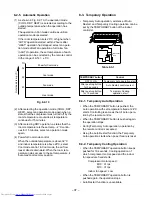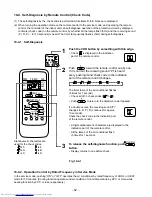
– 44 –
Press
(un-hook)
1 Installation
plate
Hook here
2
Hook
1
Shield pipe (local parts)
Extension drain hose
Inside the room
Drain hose
Fig. 9-2-16
Fig. 9-2-15
CAUTION
Arrange the drain pipe for proper drainage
from the unit.
Improper drainage may result in dew-dropping.
9-2-7. Indoor Unit Fixing
1. Pass the pipe through the hole in the wall,
and hook the indoor unit on the installation
plate at the upper hooks.
2. Swing the indoor unit to right and left to
confirm that it is firmly hooked up on the
installation plate.
3. While pressing the indoor unit onto the wall
by the lower part, hook it up on the
installation plate by the lower part. Pull the
indoor unit toward you by the lower part to
confirm that it is firmly hooked up on the
installation plate.
9-2-8. Setting of Remote Control
Selector Switch
When two indoor units are installed in the
separated rooms, there is no need to change
the select switches.
Remote Control Selector Switch
• When two indoor units are installed in the
same room or adjacent two rooms, if
operating a unit, two units may receive the
remote control signal simultaneously and
operate. In this case, the operation can be
preserved by setting either one indoor unit
and remote control to B setting (Both are
set to A setting in factory shipment).
• The remote control signal is not received
when the settings of indoor unit and remote
control are different.
• There is no relation between A setting/B
setting and A room/B room when
connecting the piping and cables.
1. Setting of remote control switch at the
indoor unit side
• Remove the front panel.
(1) Before you open the front panel, be sure to
turn off the circuit breaker or the main power
switch.
(2) Open the screw caps and remove the two
screws securing the front cabinet.
(3) Close the screw caps.
(4) Open the vertical air flow louver horizontally
by hand.
(5) Slightly open the lower part of the front
cabinet then pull the upper part of the front
cabinet toward you to remove it from the rear
panel.
How to remove the front cabinet
(5)
(5)
(2) (3)
Vertical air flow louver
(4)
(2) (3)
How to open the screw cap
Fig. 9-2-18
• Place your finger on the lower part and
push to open the screw cap.
• Remove the connector cover.
(1) Remove the screws securing the connector
cover.
• Remove the electrical parts cover.
(1) Remove the screws securing the electrical
parts cover.
• Change the remote control selector switch
to [B].
(1) Pull out P.C. board from the electrical parts
box up to the place where the remote control
selector switch can be observed.
(2) Change both switches.
(3) Return the P.C. board to original position.
• Mount the electrical parts cover and the
connector cover each with screws.
• Mount the front panel.
After fastening the two screws, one each at the
left and right of the air outlet, be sure to push
the upper center (1), right end (2), left end (3)
and the lower center part (4) of the air outlet,
and confirm that no gap is left between the
front panel and the rear plate.
• If cooling (dry) operation is made without
pushing the air outlet, dew can be deposited
on the front panel surface. In addition a gap
between the front panel and the rear plate
will become wider, spoiling the appearance.
• Adhesion of B label (When setting to [B])
Be sure to adhere the B label above the label
and on the remote control.
50 mm
or more
Do not rise the
drain hose.
Do not form the drain hose
into the waved shape.
Do not put the
drain hose end
into water.
Do not put the drain
hose end in the
drainage ditch.
Fig. 9-2-14
2. Put water in the drain pan and make sure that
the water is drained outdoors.
3. When connecting extension drain hose,
insulate the connecting part of extension drain
hose with shield pipe.
9-2-6. Drainage
1. Run the drain hose sloping downwards.
• Hole should be made at a slight downward
slant to the outdoor side.
Fig. 9-2-17
Screws
Screws
Connector cover
Electrical parts cover
Pull out
P.C. board
Switch
(Selector switch)
3
1
2
4
Push
Push
Push
Push
B label
Color label
8
A setting
B setting
ON
1
2
ON
1
2
Fig. 9-2-19
• How to set the remote control selector
switch
Fig. 9-2-20
















































